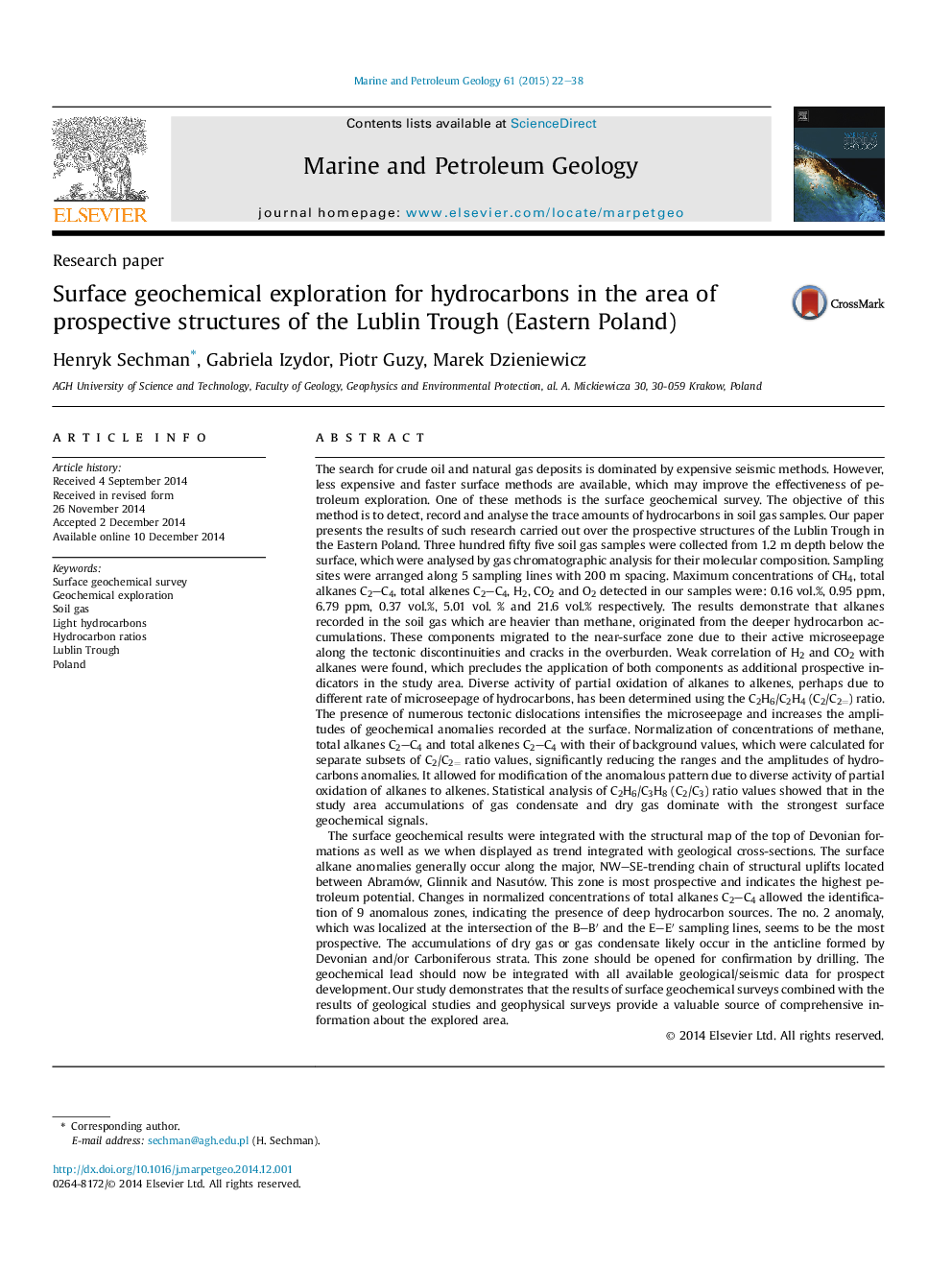| کد مقاله | کد نشریه | سال انتشار | مقاله انگلیسی | نسخه تمام متن |
|---|---|---|---|---|
| 6435184 | 1637164 | 2015 | 17 صفحه PDF | دانلود رایگان |

- Alkanes in soil gas are result of microseepage from subsurface accumulations.
- Condensate and dry gas gives the strongest geochemical signals at the surface.
- Faults and fractures in overburden intensifies hydrocarbon microseepage.
- Separate backgrounds for subset of C2/C2= ratio - better anomaly distribution.
The search for crude oil and natural gas deposits is dominated by expensive seismic methods. However, less expensive and faster surface methods are available, which may improve the effectiveness of petroleum exploration. One of these methods is the surface geochemical survey. The objective of this method is to detect, record and analyse the trace amounts of hydrocarbons in soil gas samples. Our paper presents the results of such research carried out over the prospective structures of the Lublin Trough in the Eastern Poland. Three hundred fifty five soil gas samples were collected from 1.2Â m depth below the surface, which were analysed by gas chromatographic analysis for their molecular composition. Sampling sites were arranged along 5 sampling lines with 200Â m spacing. Maximum concentrations of CH4, total alkanes C2-C4, total alkenes C2-C4, H2, CO2 and O2 detected in our samples were: 0.16 vol.%, 0.95Â ppm, 6.79Â ppm, 0.37 vol.%, 5.01 vol. % and 21.6 vol.% respectively. The results demonstrate that alkanes recorded in the soil gas which are heavier than methane, originated from the deeper hydrocarbon accumulations. These components migrated to the near-surface zone due to their active microseepage along the tectonic discontinuities and cracks in the overburden. Weak correlation of H2 and CO2 with alkanes were found, which precludes the application of both components as additional prospective indicators in the study area. Diverse activity of partial oxidation of alkanes to alkenes, perhaps due to different rate of microseepage of hydrocarbons, has been determined using the C2H6/C2H4 (C2/C2=) ratio. The presence of numerous tectonic dislocations intensifies the microseepage and increases the amplitudes of geochemical anomalies recorded at the surface. Normalization of concentrations of methane, total alkanes C2-C4 and total alkenes C2-C4 with their of background values, which were calculated for separate subsets of C2/C2= ratio values, significantly reducing the ranges and the amplitudes of hydrocarbons anomalies. It allowed for modification of the anomalous pattern due to diverse activity of partial oxidation of alkanes to alkenes. Statistical analysis of C2H6/C3H8 (C2/C3) ratio values showed that in the study area accumulations of gas condensate and dry gas dominate with the strongest surface geochemical signals.The surface geochemical results were integrated with the structural map of the top of Devonian formations as well as we when displayed as trend integrated with geological cross-sections. The surface alkane anomalies generally occur along the major, NW-SE-trending chain of structural uplifts located between Abramów, Glinnik and Nasutów. This zone is most prospective and indicates the highest petroleum potential. Changes in normalized concentrations of total alkanes C2-C4 allowed the identification of 9 anomalous zones, indicating the presence of deep hydrocarbon sources. The no. 2 anomaly, which was localized at the intersection of the B-Bâ² and the E-Eâ² sampling lines, seems to be the most prospective. The accumulations of dry gas or gas condensate likely occur in the anticline formed by Devonian and/or Carboniferous strata. This zone should be opened for confirmation by drilling. The geochemical lead should now be integrated with all available geological/seismic data for prospect development. Our study demonstrates that the results of surface geochemical surveys combined with the results of geological studies and geophysical surveys provide a valuable source of comprehensive information about the explored area.
Journal: Marine and Petroleum Geology - Volume 61, March 2015, Pages 22-38